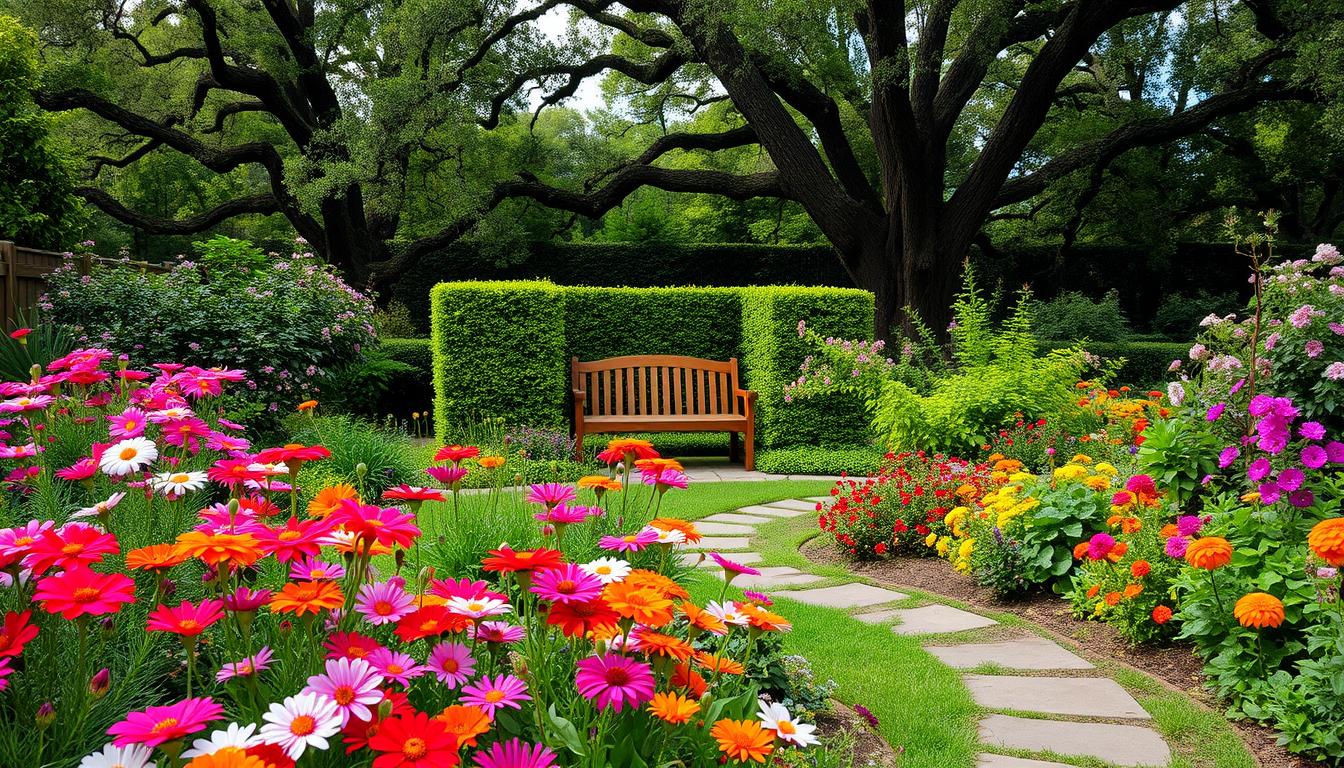Creating a thriving outdoor space can be a rewarding experience for everyone, regardless of skill level. Whether you’re looking to grow fresh produce or simply enjoy the beauty of nature, a well-planned area can make all the difference. With the right approach, you can turn even the smallest plot into a lush, productive haven.
One of the greatest benefits of this activity is the chance to enjoy homegrown vegetables and herbs. Not only does it save money, but it also promotes a healthier lifestyle. Plus, it’s a fantastic way to spend time outdoors and bond with family or friends.
From planning and soil preparation to planting and maintenance, this guide will walk you through the essentials. Learn how raised beds and vertical techniques can maximize limited areas. Discover tips from experts and real-life success stories to help you avoid common pitfalls.
Key Takeaways
- Backyard gardening is suitable for all skill levels.
- Enjoy fresh produce and outdoor exercise.
- Raised beds and vertical methods save space.
- Proper planning and soil prep are crucial.
- Learn from others’ experiences to avoid mistakes.
Introduction to Backyard Gardening
Growing your own plants is a simple yet impactful way to connect with nature. It’s not just about beautifying your space; it’s about creating a healthier environment for yourself and your family. Plants absorb carbon dioxide, reducing your carbon footprint and contributing to a cleaner atmosphere.
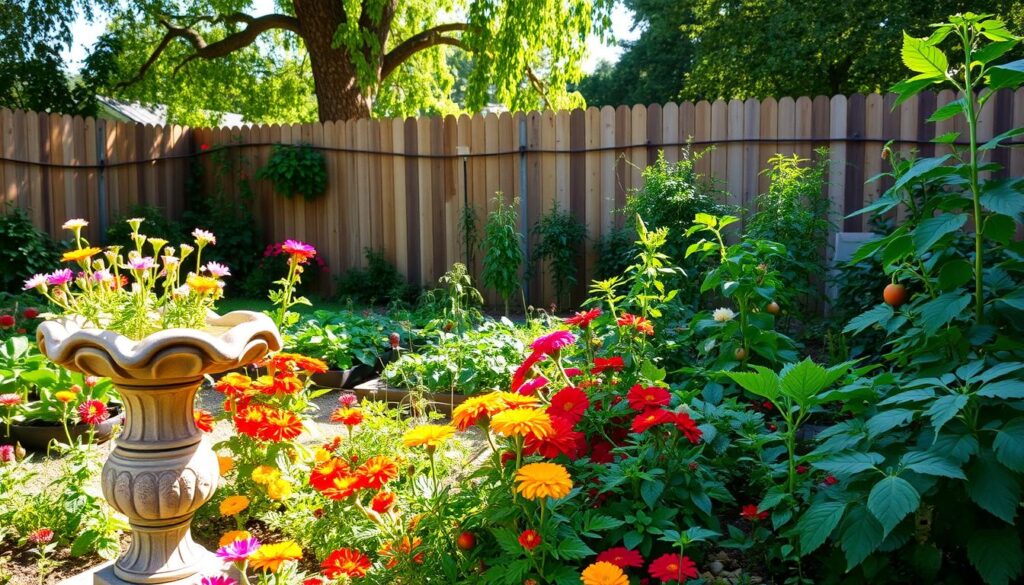
- Mental Health Improvement: Spending time outdoors reduces stress and boosts mood.
- Fresh Produce Access: Enjoy homegrown vegetables and herbs for healthier meals.
- Educational Tool for Kids: Teach children about nature and sustainability.
- Cost Savings: American families save an average of $600 annually by growing their own vegetables.
- Air Quality Improvement: Plants naturally filter the air, making your surroundings cleaner.
To ensure your plants thrive, focus on the soil. The “feed the soil” philosophy emphasizes adding organic matter like compost or shredded leaves. This improves soil fertility and structure, creating a strong foundation for healthy growth.
| Benefit | Impact |
|---|---|
| Mental Health | Reduces stress and anxiety |
| Fresh Produce | Promotes a healthier diet |
| Education | Teaches kids about nature |
| Cost Savings | Saves up to $600 annually |
| Air Quality | Filters pollutants naturally |
By nurturing your outdoor area, you’re not just growing plants—you’re cultivating a better way of life. Start small, and you’ll soon see the rewards of your efforts.
Planning Your Backyard Garden
Starting a garden requires thoughtful planning to ensure success. The right location and plant selection can make all the difference. Whether you’re working with a small area or a larger plot, careful preparation will set the foundation for a thriving outdoor space.
Choosing the Right Location
Sunlight is one of the most critical factors for a healthy garden. Most vegetables need at least 6-8 hours of direct sunlight daily. Use smartphone apps to track sunlight patterns in your yard. This helps you identify the best spots for planting.
Proximity to water is another consideration. Ensure your garden is close to a water source for easy irrigation. Raised beds and container gardening are excellent options for areas with limited space or poor soil quality.
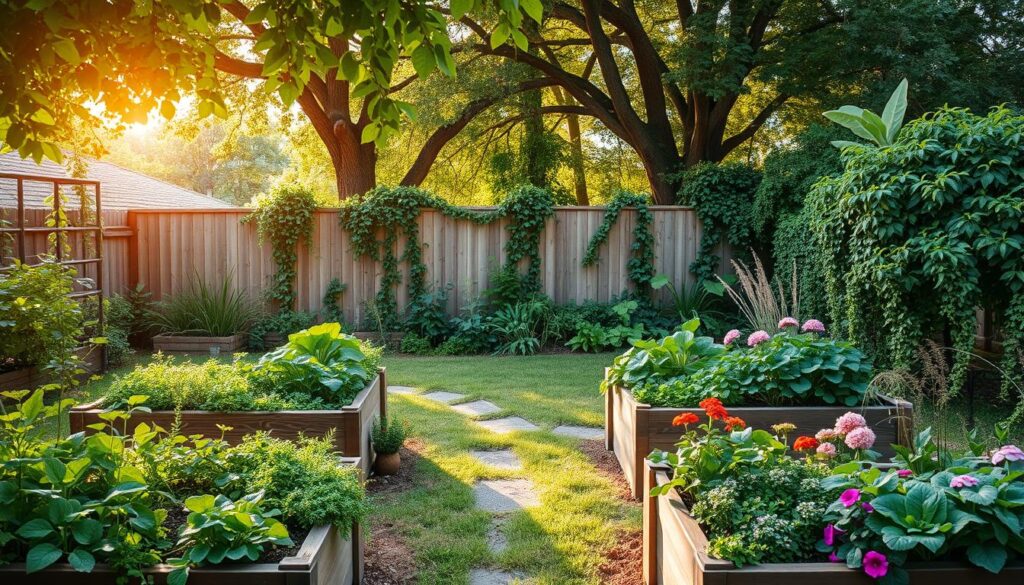
Deciding What to Grow
Your plant selection should align with your climate and available space. Refer to USDA planting calendars to determine the best crops for your zone. For example, tomatoes thrive in full sun, while lettuce prefers partial shade.
Here’s a quick guide to help you decide:
| Plant | Sunlight Requirement |
|---|---|
| Tomatoes | Full Sun |
| Lettuce | Partial Shade |
| Strawberries | Full Sun |
| Herbs | Partial to Full Sun |
For small spaces, consider vertical gardening solutions like strawberry towers or herb spirals. These methods maximize space while adding visual interest to your garden.
Ready to get started? Check out this beginner’s guide for more tips on planning your garden.
Preparing the Soil
Healthy soil is the foundation of a thriving outdoor space. Without proper preparation, even the best plants may struggle to grow. Testing and amending the soil ensures it has the right nutrients and structure for success.
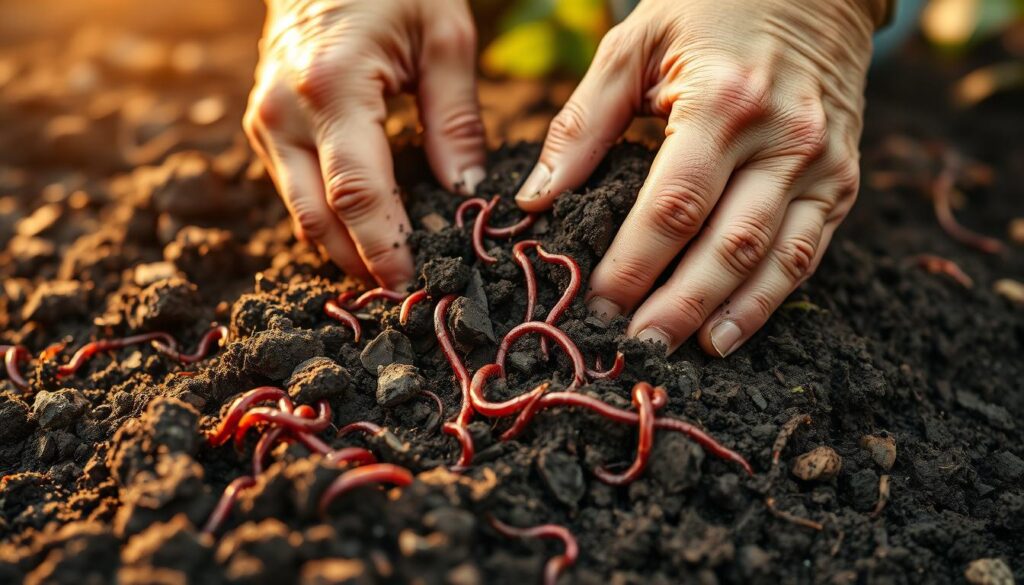
Testing and Amending the Soil
Start by testing your soil’s pH level using a home kit. The ideal range for most plants is between 6.0 and 7.0. If the pH is too high or low, you can adjust it with lime or sulfur.
Next, focus on improving the soil’s texture and fertility. A simple recipe for a healthy mix includes 40% compost, 40% topsoil, and 20% perlite. Adding organic matter like compost or shredded leaves enhances soil structure and provides essential nutrients.
Building Raised Beds
Raised beds are a great solution for areas with poor soil or limited space. They offer better drainage and easier access for planting and maintenance. A standard width of 4 feet ensures you can reach the center without stepping on the soil.
For a sustainable approach, consider lasagna gardening. Layer materials like cardboard, coffee grounds, and compost to create a nutrient-rich bed. When choosing materials, cedar is durable and long-lasting, while composite options are low-maintenance.
By preparing your soil and building raised beds, you’ll create a strong foundation for a productive and beautiful space.
Planting Your Garden
Planting your outdoor space is the most exciting step in creating a lush, productive area. Whether you’re starting from seeds or transplants, proper techniques ensure your plants thrive. Thoughtful spacing and arrangement also play a key role in maximizing your space.
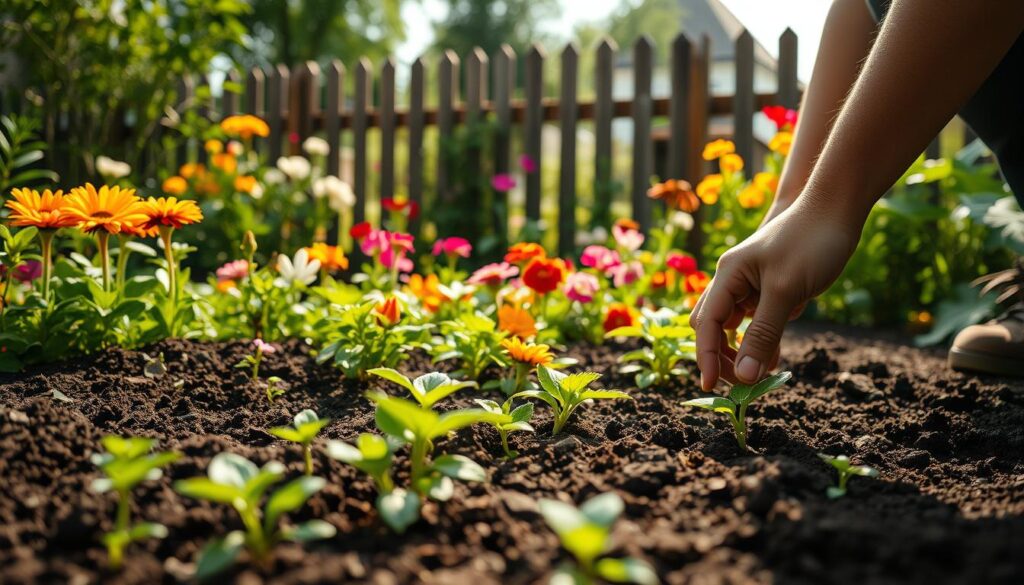
Starting from Seeds vs. Transplants
Starting from seeds offers a cost-effective way to grow a variety of plants. Begin 8-10 weeks before the last frost date for best results. Use peat pellets or soil blocks for better germination rates. Tomatoes and peppers are excellent choices for time-saving transplants, as they establish quickly and produce abundant yields.
For beginners, transplants are often easier to manage. They skip the delicate germination phase and are ready to thrive in your garden. However, seeds allow for a wider selection of plant varieties and can be more rewarding for experienced gardeners.
Spacing and Arrangement
Proper spacing ensures your plants have enough room to grow. Square foot gardening is a popular method, allowing you to plant 16 carrots per square foot. Raised beds are ideal for optimizing space and improving drainage.
Companion planting is another effective strategy. Pairing plants like tomatoes and basil can deter pests and enhance growth. Succession planting extends your harvest by rotating crops throughout the season. For example, follow early-season lettuce with warm-weather beans.
Here’s a quick guide to spacing and arrangement:
- Carrots: 16 per square foot
- Tomatoes: 1 per 2 square feet
- Lettuce: 4 per square foot
- Peppers: 1 per square foot
By following these tips, you’ll create a well-organized and productive space for your plants to flourish.
Watering and Fertilizing
Proper watering and fertilizing are essential for maintaining healthy plants and ensuring a thriving outdoor space. These practices not only support growth but also prevent common issues like nutrient deficiencies and drought stress. With the right approach, you can keep your plants vibrant and productive throughout the season.
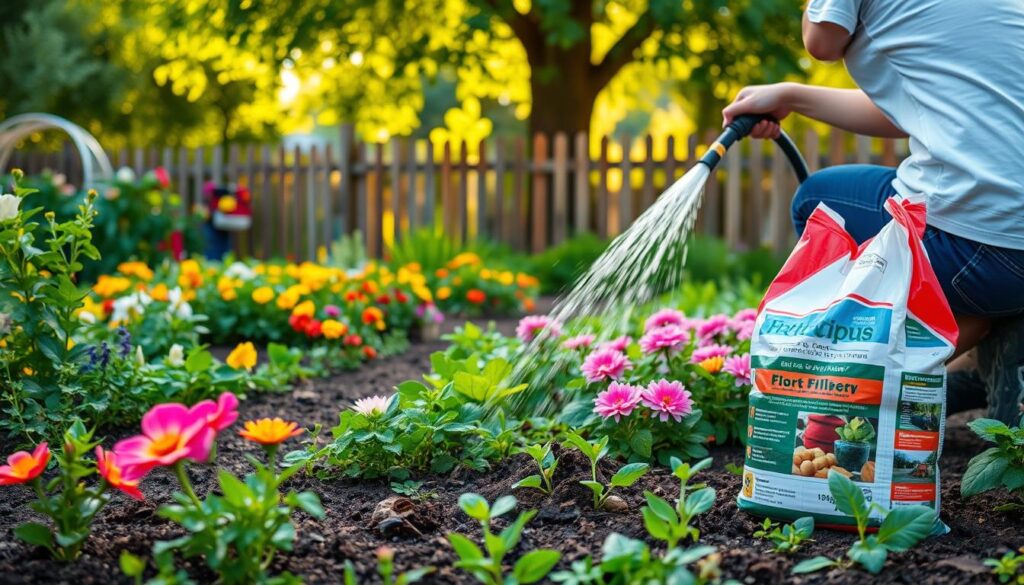
Establishing a Watering Schedule
Consistent watering is key to plant health. A good rule of thumb is to provide about 1 inch of water weekly, adjusting for rainfall. To check soil moisture, use the finger test—insert your finger into the soil up to the second knuckle. If it feels dry, it’s time to water.
Drip irrigation is an efficient method that delivers water directly to the roots, reducing waste. Compared to soaker hoses, it’s more cost-effective in the long run. For a sustainable option, consider installing a DIY rain barrel to collect and reuse rainwater.
Choosing the Right Fertilizer
Fertilizers provide essential nutrients that plants need to thrive. Organic options, like fish emulsion with an NPK ratio of 5-3-4, are gentle on the environment and improve soil health. Compost tea is another excellent choice, offering a rich blend of nutrients and beneficial microbes.
When applying fertilizer, follow the instructions on the label to avoid overfeeding. Too much can harm plants and disrupt soil balance. Incorporating organic matter, such as compost, into the soil also enhances fertility and structure naturally.
Managing Pests and Diseases
Keeping your plants healthy requires vigilance against pests and diseases. These challenges can threaten your vegetables and reduce your harvest. However, with the right strategies, you can protect your outdoor space and ensure thriving growth.
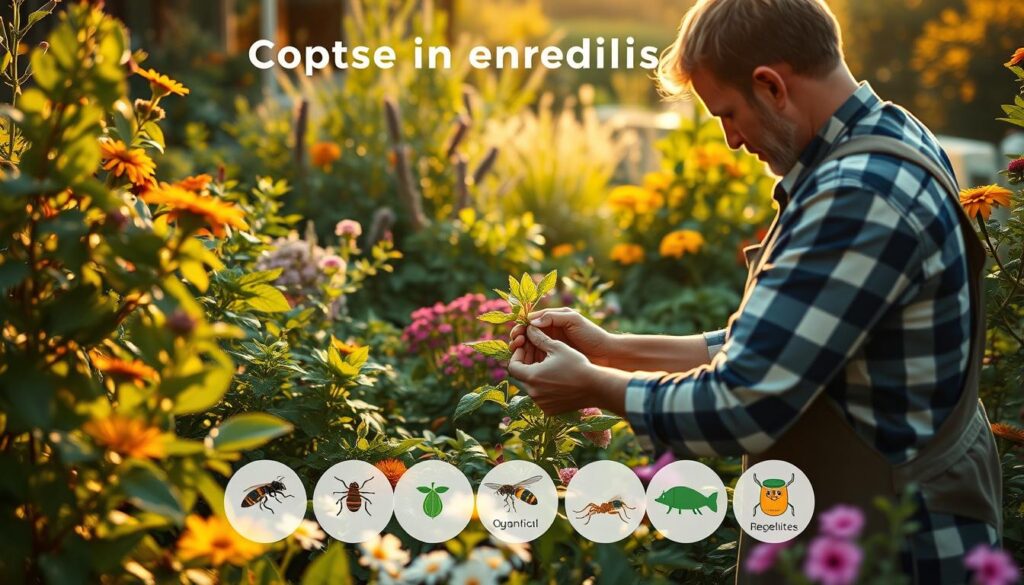
Identifying Common Pests
Pests like aphids, squash bugs, and beetles can damage your plants. Aphids are small, green insects that suck sap from leaves. Squash bugs attack zucchini and pumpkins, while beetles chew through foliage.
To combat these pests, try a homemade garlic spray. Mix 10 cloves of garlic with water and let it sit overnight. Strain and spray on affected plants. This natural remedy is safe and effective.
Preventing and Treating Diseases
Diseases like blight and mildew can spread quickly. Crop rotation is a great way to prevent these issues. Avoid planting the same vegetables in the same spot year after year.
Beneficial insects like ladybugs and lacewings can also help. They prey on harmful pests, keeping your plants safe. For added protection, choose disease-resistant varieties like ‘Defiant’ tomatoes.
“Companion planting and natural remedies are key to a healthy garden.”
| Pest/Disease | Solution |
|---|---|
| Aphids | Garlic spray |
| Squash Bugs | Neem oil |
| Blight | Crop rotation |
| Mildew | Resistant varieties |
By staying proactive, you can keep your plants healthy and enjoy a thriving outdoor space. Whether it’s using natural sprays or inviting beneficial insects, these methods ensure your vegetables flourish.
Pruning and Maintenance
Pruning and regular upkeep are essential for thriving plants. These practices not only enhance their appearance but also promote healthier growth. By dedicating a little time each week, you can keep your outdoor space vibrant and productive.

Pruning Techniques
Proper pruning ensures plants grow strong and produce abundant yields. For roses, try the Missouri pruning method. Remove only the top third of the stem to encourage new growth and prevent damage.
Tomatoes benefit from suckering, a process that removes small shoots between the main stem and branches. This directs energy toward fruit production. Always use clean, sharp tools to avoid spreading diseases.
Regular Maintenance Tasks
Weekly tasks like weeding and thinning help plants thrive. Remove weeds to reduce competition for nutrients and water. Thin overcrowded seedlings to give each plant enough space to grow.
Sterilize tools after each use to prevent the spread of pests and diseases. A simple solution of bleach and water works well. Seasonal maintenance, such as preparing beds in the fall, ensures your space is ready for the next growing season.
Mulching is another effective way to keep plants healthy. It retains moisture, regulates soil temperature, and suppresses weeds. For fruit trees, consider espalier training to save space and improve air circulation.
“Regular care and attention are the keys to a thriving outdoor space.”
- Use Missouri pruning for roses to encourage growth.
- Remove tomato suckers to boost fruit production.
- Weed and thin plants weekly for better results.
- Sterilize tools to prevent disease spread.
- Prepare beds in the fall for the next season.
By following these tips, you can maintain a healthy and beautiful outdoor area. Whether it’s pruning or seasonal care, these practices ensure your plants flourish year after year.
Harvesting Your Garden
Harvesting your own produce is the most rewarding part of gardening. It’s the moment when all your hard work pays off, and you get to enjoy fresh, homegrown vegetables and fruits. Knowing when and how to harvest ensures you get the best flavor and quality from your plants.
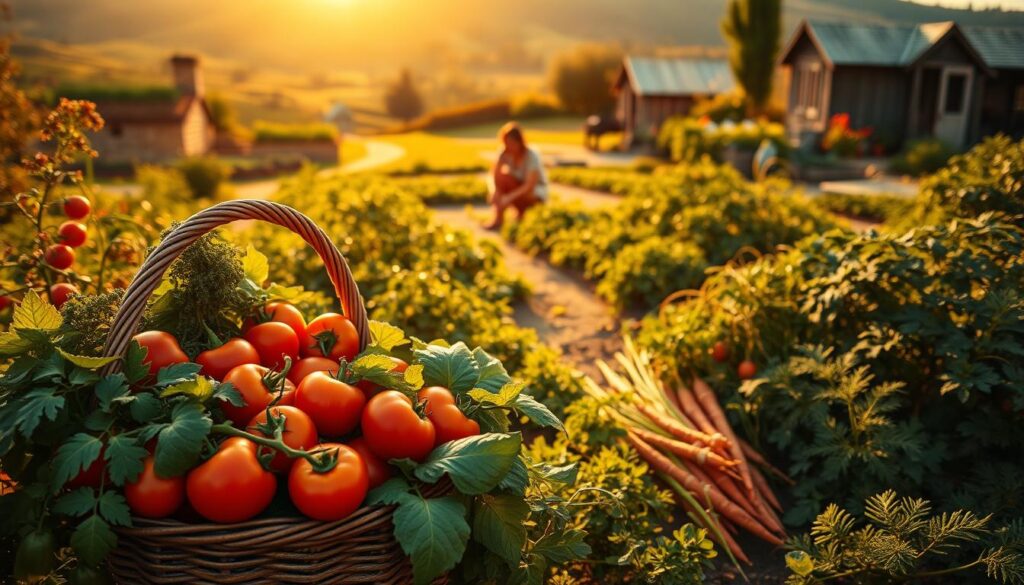
Knowing When to Harvest
Timing is everything when it comes to harvesting. For tomatoes, look for a deep, even color and a slight give when gently squeezed. Green beans should be firm and snap easily. Root vegetables like carrots and beets are ready when their tops peek out of the soil.
Succession harvesting is a great way to extend your growing season. Plant crops in intervals to ensure a continuous supply of fresh produce. For example, sow lettuce seeds every two weeks for a steady harvest.
- Tomatoes: Deep color and slight firmness indicate ripeness.
- Green Beans: Blanch and freeze for long-term storage.
- Root Vegetables: Harvest when tops are visible.
Storing and Preserving Your Harvest
Proper storage keeps your vegetables and fruits fresh for longer. Root cellars are ideal for storing potatoes, carrots, and onions. Keep the temperature between 32-40°F and humidity around 90% for optimal conditions.
Canning and pickling are excellent ways to preserve cucumbers and other produce. A simple pickling recipe includes vinegar, water, salt, and spices. Dehydrating herbs is another option, though freezing retains more flavor.
“Preserving your harvest ensures you enjoy fresh produce year-round.”
| Method | Best For |
|---|---|
| Root Cellar | Potatoes, carrots, onions |
| Canning | Cucumbers, tomatoes |
| Dehydrating | Herbs, fruits |
| Freezing | Green beans, herbs |
By mastering these techniques, you can enjoy the fruits of your labor long after the growing season ends. Whether it’s canning, freezing, or storing in a root cellar, preserving your harvest is a rewarding post-gardening activity.
Getting Kids Involved in Gardening
Gardening with kids is a fantastic way to spark curiosity and teach valuable life lessons. It’s a hands-on activity that combines learning, creativity, and fun. Whether you’re planting flowers or growing vegetables, children can discover the joy of nurturing plants and watching them thrive.
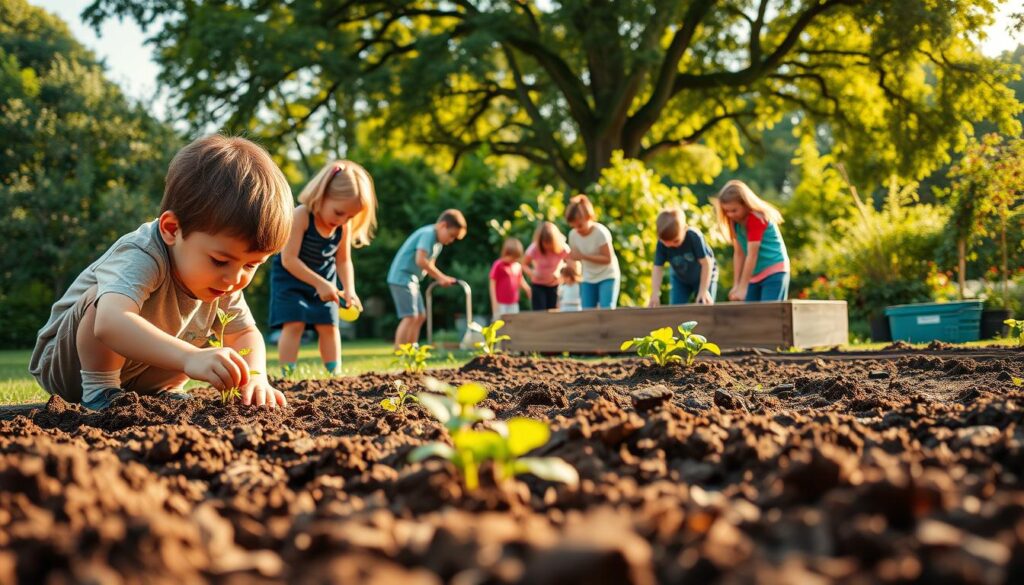
This activity is not just about growing plants; it’s about fostering a connection with nature. Kids learn responsibility, patience, and the importance of caring for the environment. Plus, it’s a great way to spend quality time together as a family.
Fun Gardening Activities for Kids
Engage children with creative projects that make gardening exciting. A sunflower house is a perfect example. Plant sunflowers in a circle, leaving space for a doorway. As they grow, they’ll create a natural playhouse for kids to enjoy.
Another fun idea is a butterfly life cycle station. Plant flowers that attract butterflies and teach kids about their life stages. Scavenger hunts for beneficial insects like ladybugs add an element of adventure to the garden.
- Sunflower House: Create a living play space with tall sunflowers.
- Butterfly Station: Plant flowers to attract and observe butterflies.
- Seed Tape: Teach kids to make their own seed tape for easy planting.
- Worm Bin: Build a compost bin to show the importance of recycling.
Teaching Kids About Nature
Gardening is a great way to introduce children to the wonders of nature. They’ll learn about the life cycle of plants, the role of pollinators, and the importance of healthy soil. These lessons can inspire a lifelong appreciation for the environment.
For example, a pizza garden is a fun and educational project. Plant tomatoes, basil, and peppers in the shape of a pizza slice. Kids will love growing their own food and using it to make a meal.
“Gardening teaches kids patience, responsibility, and the value of hard work.”
By involving kids in gardening, you’re not just growing plants—you’re nurturing future stewards of the earth. For more tips on family-friendly gardening, check out this beginner’s guide.
Creating a Beautiful Backyard Garden
Transforming your outdoor area into a stunning retreat is easier than you think. With thoughtful design and creative touches, you can turn any space into a personal oasis. Whether you’re working with a small corner or a larger plot, the right approach can make all the difference.
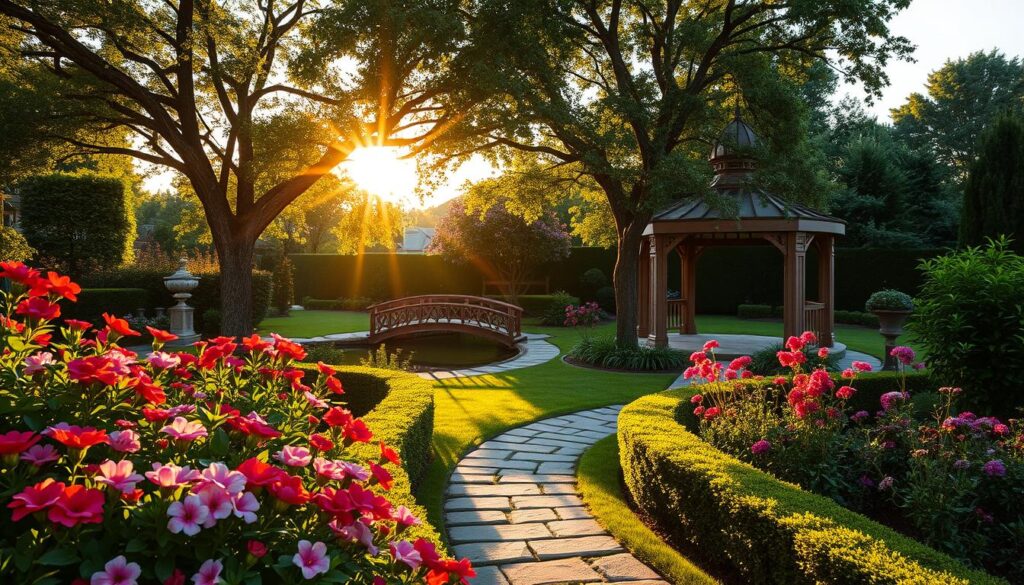
Designing Your Garden Space
Start by planning the layout to maximize functionality and beauty. Vertical garden designs are perfect for small areas, allowing you to grow more plants without taking up ground space. Use trellises, wall planters, or hanging baskets to add height and visual interest.
Color theory can also enhance your design. Pair complementary colors like purple and yellow for a vibrant look. Soft pastels create a calming atmosphere, while bold hues add energy. Consider the blooming seasons of your flowers to ensure year-round color.
- Moon Garden Plants: Include white flowers like moonflowers and evening primrose for a nighttime glow.
- Ornamental Grasses: Compare varieties like feather reed grass and fountain grass for texture and movement.
- Fragrance Garden Layout: Plant lavender, jasmine, and roses for a sensory experience.
Adding Decorative Elements
Decorative features can elevate your outdoor space. Path lighting not only adds safety but also creates a magical ambiance at night. Solar-powered lights are an eco-friendly option that’s easy to install.
Water features like fountains or small ponds bring a soothing element to your design. Regular maintenance ensures they stay clean and functional. Choose materials that complement your overall theme, such as natural stone or sleek metal.
“A well-designed outdoor space is a blend of beauty, functionality, and personal style.”
By combining thoughtful design with decorative touches, you can create a space that’s both beautiful and practical. Whether it’s a cozy corner or a sprawling retreat, your outdoor area can become a true reflection of your creativity.
Conclusion
Turning your outdoor area into a productive space is a journey worth taking. By following a three-year rotation plan, you can keep your soil healthy and your plants thriving. This process ensures long-term success and reduces the risk of pests and diseases.
Keeping a journal is a great way to track your progress. Note what works and what doesn’t, so you can improve each year. Seasonal planning calendars can also help you stay organized and make the most of your space.
Don’t forget to connect with your community! Local seed swap events are a fantastic opportunity to share resources and learn from others. Together, you can grow a vibrant and sustainable outdoor space.
Remember, every step you take brings you closer to your goals. Whether it’s your first year or your tenth, the journey is just as rewarding as the harvest. Keep going—your outdoor space is waiting to flourish!

